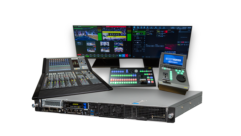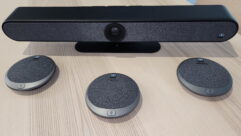

SMARTER DESIGNS FOR MISSION-CRITICAL CONTROL ROOMS IN THE BYOD ERA
BYOD, or “Bring Your Own Device,” is a hot topic with perennial relevance in AV systems design and management. Depending on who you ask, the “D” in BYOD can represent a number of different devices. Most commonly used to represent smart phones and tablets, with regards to AV infrastructure, laptops should also be included in the conversation. The dividing line isn’t necessarily what makes a device personal, but whether that device is integrated into the AV system in question, or is temporarily interfacing with it. More than 40% of employees are utilizing their own devices at the workplace, according to statistics recently released by Extreme Networks, and that figure is expected to grow every year.
A mission critical control room will have HD or UDH displays, control systems, and human interface tools that are permanently integrated and never leave the room. They will be purpose-built for those functions needed in the control room and not configured for other uses. While this can include computers and tablets, for access to content and calling up data, for example, if those devices are dedicated to the control room, they are not in the category of BYOD.
Individuals who utilize BYOD in a mission critical control room may need their own devices either because they have content they need to share that is not easily accessed without their device, or they may be authorized guests who need to share content with others within the environment. “BYOD has been proliferating across almost every space, and we’ve seen most manufacturers starting to take an app or cloud-based sharing approach, utilizing built-in security protocols and firewalls in iOS or Android OS, or by tunneling through their own cloud systems and using small download plug-ins on PC’s,” said Malik Khan, senior vice president for design and integration for ANC.
Access to the infrastructure that allows display only, such as HDMI or DVI-I connection, is typically not a security concern. These are oneway, video only connections. Another way to provide access is through IP, whether hardwired, or over WiFi. This is what creates a security consideration. As smart phones and some tablets do not have video outputs, one of the most common ways to share content from them is over IP networks.
It can be a delicate balance to provide access for mobile devices without compromising security. Matthew Kosel, technology leader and design coach for integration firm Spinitar, provided this overview of the nuances: “Placement of the BYOD device in a DMZ or on a separate access point are viable solutions but not available to all customers or networks. A solution needs to meet the network requirements while providing an excellent user experience. Not being able to access corporate email or a network drive in order for presenting to the display system in a room is not a viable solution. Integrators need to be knowledgeable in typical network topologies and security strategies while maintaining open dialog with both the network administrator and users of the systems in order to provide good BYOD solutions.”
Khan added, “For AV integrators, I think the task has become making sure that for visitors you pick one way for each major type of device to connect through the organization’s preferred control system. For example, the system could utilize only AirPlay for iOS devices, and cloud plug-ins or cast devices for PC’s, which should prevent confusion when attempting to share access.”
According to Markets & Markets, BYOD in US enterprises will grow from $35B in 2016 to $73B in 2021. Control rooms, even mission critical control rooms like traffic monitoring centers, government command centers, industrial control centers, and medical telemetry centers have not and will not be left out of the BYOD trend. Considerations that apply to all BYOD access will apply to control rooms, but with a bigger focus on stability, reliability, and low latency.
WHAT’S UX GOT TO DO WITH IT?
For technology professionals, the focus is often on the hardware, configuration software, and physical considerations like racks, cooling, and cabling. For the users of AV systems, much—if not all—of that is invisible, and the only thing that matters is the interface for controlling the system. The average knowledge worker is probably not thinking about the network switches, rights access system, and file servers when accessing a centrally stored Excel spreadsheet from a shared network drive. This is conceptually the same with the control interface for an AV system. The average user is only thinking about what needs to be seen and heard and where it needs to be seen and heard.
Mission-critical AV systems elevate the importance of the interface design. Time and accuracy become paramount, and mistakes with AV system control are not just an inconvenience, they have real and immediate consequences. What the user experiences in trying to control the system is what defines its usefulness. This is what “UX” refers to with regards to highly agile and mission-critical AV systems. Sometimes there is confusion that UX only means how pleasant, bright, organized, and easy a device is to use. But in the modern agile control room, the experience extends to performing the correct action, performing it quickly, and knowing that it has been done.
“UX is even more prominent in systems that are of a critical nature, such as control rooms, war rooms, hospitals, and life safety systems,” explained Steve Greenblatt, CTS, the president and founder of Control Concepts, a leading provider of specialized software and services for the audiovisual industry.
Greenblatt added that users in contemporary command and control spaces must have information and controls at their fingertips, with the access and ability to make split-second decisions. Furthermore, they need to have the confidence in knowing that they are ‘in control’ of the system.
“There may be no leeway for user error nor time to hunt for the right button or become oriented with the UI,” Greenblatt said. “If an AV system is not easy to operate and or doesn’t satisfy a need, it does not have value to the user.”
One only needs to read a handful of press releases from the last InfoComm event to see the word “intuitive” attached to nearly any AV product solution and interface. Unlocking what truly makes a control system intuitive is much larger than a bullet point on a datasheet.
A theoretically ideal interface allows the user to perform the exact function desired, without hesitation, in minimal steps, accurately, and without training. That is a high expectation, and there are different interpretations of what that all means. While there is grey area, the latter point, a control interface that requires no training, encompasses the other points, and gets at the heart of what would be an ideal interface. A simple toggling light switch is a nearly ideal interface. We had all been trained on how it works by just the experience of seeing someone else do it when we were young. There is one action to perform. It is a simple action, it can be done with a high degree of accuracy, and if the light is functioning properly, there is instant feedback that it worked.
Even in a mission-critical command center, the AV system control interface should be this straightforward. A simple action learned easily by experience, with limited sorting of options, a high degree of predictable accuracy, and instant feedback indicating the result of the action performed. In mission-critical applications, both time and accuracy are of great importance for effective operation and excellent user experience. The design and implementation of the interface is a crucial part of this. The systems behind the interface must be robust, with low-latency, flexibility, and reliability; but sub-frame latency is only so useful if a user needs ten seconds to figure out how to perform a function.
An interface that can achieve this kind of user experience is possible with the right hardware and collaboration between those who use the room and those who will be designing the system.
The control system, its infrastructure, and how it operates cannot just be afterthoughts attached to a gear list and wiring schematics. Careful consideration of the needs of the room and its users, and open collaboration are critical and must occur as early in the design process as possible.
DATA DRIVEN COLLABORATION AND CONTROL ROOMS
Data. It’s tempting to simply think of it as the content that is displayed and distributed on AV systems that isn’t video. Several trends are coming together and increasing the value and need for data driven design in collaboration spaces and control rooms; the rapid access to unfathomable amounts of data, the increase in focus on remote collaboration, and the influx of interactive touch displays.
“Think of the way people work on decision making in a non-technology equipped space,” says Craig Park, principal consultant with The Sextant Group. “They use whiteboards, sticky notes, and easels. Ideas get thrown up on the wall and then some sort of decision process is applied. This includes people interacting with the sticky notes, or the ideas written on large easels, or whiteboards. The output is a set of decisions or actions that are then recorded and saved.”
Technology has evolved to duplicate this type of work process including software that emulates the use and manipulation of sticky notes, white boarding, and other activities that reflect how knowledge workers collaborate in non-technological ways. The remaining question is how data facilitate these processes and how the technology can further enhance the use of data.
A group of collaborators will seek to use data as part of their decision process now more than in years past because so much data is available with a lower access burden than ever before. Participants will have their own collected data from their area of expertise that that will want to share. Organizational data in shared network locations and data from outside the organization become a crucial part of the collaboration as well. Park states, “Decision making is more effective when it includes real data rather than solely opinion or experiential insights.”
With regards to designing collaboration spaces or control rooms, this means planning ahead for data to be a tool to be utilized in the space, not just other content. The first step is ensuring the displays and the backbone of the video distribution system are equipped to handle data. The effective use of data, however, goes beyond the displaying of it.
The design implications include understanding what data will be required in the space, where that data going to come from, how participants connect and access it, and how participants share their own data from their own device. The design and implementation of available technology is significantly more effective when these factors are considered early in the process.
Another element in data visualization is the use of data outside of static data used for decision making and collaboration. In control room applications, data can mean real time information that is part of managing and operating a process. Manufacturing control rooms will need to access productivity and uptime statistics. Industrial drilling control rooms monitor environmental conditions, equipment conditions and telemetry, and other safety data in real time. Intensive Care facilities feature telemetry stations for monitoring patients. These are just a few examples in which data is the critical content and drives the design of the room and the technology implemented.
Data is everywhere. That kind of ubiquity can lead to a casual attitude towards the access and display of data in our collaborative spaces and control rooms. If virtually any data can be accessed in the palm of the hand in moments, then certainly a technologically equipped room can access it as well. The power of intentional data driven design is bigger than that and can unlock more effective and profitable decision making, as well as the real-time management of data driven processes.
DISTRIBUTING MOBILE & IP-BASED FEEDS
Distributing a video feed to multiple recipients comes with many technical challenges, but it also offers many opportunities. While control rooms for distribution get a lot of attention for the monitoring and management of distributed feeds, the core concerns are essential to effective systems. Whether sending video to ten recipients or one thousand, scalability, compression, bandwidth, and security concerns demand critical attention. A methodology and infrastructure that address these challenges can increase opportunities for content delivery and communication.
To manage any reasonable distribution of video to more than just a handful of recipients, IP-based methods allow for the greatest flexibility and scalability. Content distribution networks provide the opportunity to send feeds locally, across a campus, or over the Internet to remote locations. In nearly all cases, the devices receiving the feed can range from mobile technologies operating over WiFi and cellular networks to hardwired decoders and video-wall processors. Managing video streams with bandwidths ranging from as low as 1 to 5 Mbps up to 10+ Gbps necessitates that IP-based video streams be used in order to create not only a one-to-many distribution, but also to enable reception via many different endpoint types.
Not only does a video distribution network allow for this type of flexibility and scalability, it also provides opportunity for creative innovations. An example of this is the inclusion of near real-time streaming that can be integrated into digital signage with the RGB Spectrum Zio family of encoders and decoders. Typically, digital signage is a form of digital content distribution, but it can tend to be less time critical than a live video feed, for example. But if it is useful to include a live image in near real-time to enhance the digital signage, the Zio products can provide this.
“By sending real time streaming video content from Zio encoders in parallel to data visualization information from a signage network, both landing on Zio decoders for simultaneous display, a complete operating picture of a factory line can be distributed company wide, quickly and easily,” said Bob Ehlers, vice president of business development for RGB Spectrum.
One to many, near real-time distribution of video feeds also requires attention to security concerns. While the industry has not converged on standards, there are a variety of protocols that can be implemented by knowledgeable IT experts to keep visual information away from prying eyes. This is less difficult in a closed system that doesn’t require the interoperations of devices from different manufacturers. The natural evolution, however, does appear to favor interoperability and should converge on specific standards of protection.
Planning for a content distribution network and gearing it for the future means giving attention to the size and scalability of the intended network, the different bandwidth requirements of the receiving devices, and exploring manufacturers that are attentive to the rapidly changing security concerns of our evolving AV landscape.










